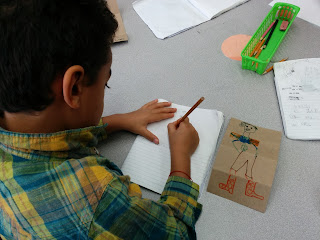We continue to write and read aloud our stories in Writer's Workshop. After talking about setting and actions, we moved on to talk about characters in our stories. We brainstormed a new list of possibilities for characters. We did an art activity, drawing part of a character and then passing along the paper for the next person to add onto ("Exquisite Corpse"). Afterwards, each student received the character whose head they had drawn, with body parts drawn by different people. I put the students into pairs and asked them to tell their partner (in French) about their character. Students were then invited to write their next story about that character.
This past week we have been talking about how a good story has a problem and a solution. When we tell a story around the circle with the talking piece, we try to introduce a problem and then create a solution.
In Daily 5 we are now doing Read to Self, Partner Reading, Listening to Reading (on headphones along with the book) and Word Work. The kids have been using iPads for their Word Work, using an app called French Words for Kids. This is an excellent app for teaching phonics, reading, spelling and vocabulary, check this link for a review: http://frenchappsforkids.blogspot.ca/2013/02/french-words-for-kids-montessori.html.
I talked to the class about how to hold a pencil and why it matters. After assessing how each student holds their pencil, I handed out "pencil grips" to some of them. The most common problem is the "thumb wrap", so those kids are training their thumbs to be in contact with the pencil with the help of a pencil grip.
Our weekly sight words were with the sound on/om and then in/im/ain. We practiced the sight words by saying them with the phonic gestures we have been learning, by writing them and by making sentences with them. We did drills with hard and soft "c" and "g" as well.
In math we have been working with equations using "greater than" (>) and "less than" (<). We looked at a balance scale with more cubes on one side to illustrate the idea. Later we put 2 colours of cubes on each side, to illustrate equations like 4+2 > 3+1. The same balance scale analogy was used as we moved into equations of equality. In grade 1 students often think that "=" means "the answer is...", so we did activities to get across how the symbol "=" means "is the same as" and that a math equation or math sentence can be read forwards and backwards and tells about relationships between numbers. To show an equality equation we put 3 red cubes and 2 black cubes on one side of the balance scale, and 1 red cube and 4 black cubes on the other side. The scale was balanced with the same weight on either side and we represented this as 3+2 = 1+4. We followed this up with equality equations with an unknown number that the kids had to deduce. We also took a break from this rather heavy math to play Dreidel for Chanukah, and got more familiar with the concept of "half" while we were at it.
In science we have started a unit on "Living Things" which focuses on the needs and characteristics of plants and animals, and environmental stewardship. We began by talking about what we already know about. We made 5 posters, with a section contributed by each table, that use drawings and words to tell what we know about the needs of plants, the characteristics of plants, the needs of animals, the characteristics of animals, and how to protect the environment. We went over all that we know already, and then began developing questions for what we'd like to find out more about.
We have a collection of simple books about plants and animals, so our next activity had each student choose a book, read it over, and then draw and write about what they found most interesting in the book. Each student presented their drawing and writing to the class.
In order to talk about animal characteristics, we need to have the vocabulary for body parts. So we reviewed those words by making a class book. For each body part, 2 kids worked together to make a collage of magazine pictures representing it. The pages were bound together into a book.
We've also been working hard to prepare a dance number for the Holiday Concert next week. The kids did free dance movements to the tune "Tout va être OK" (https://www.youtube.com/watch?v=JaTI6VP5QQg). Then we analyzed the song to identify slow parts, building parts, and high energy parts. We decided that the slow parts would be floor movements, the building parts would be walking movements, and the high energy parts would be stationary jumping movements. Then I split the class into 3 groups, and each group came up with movements for one of those moods. I made a video as each student presented their idea for a dance move, and then I put their dance movements together into a dance piece which we have been practicing. I can't wait to see them perform it in front of an audience!
Lastly, we made gingerbread cookies for Christmas. Thanks to the moms who came and made it all possible!
Cookies will be coming home on Monday!















No comments:
Post a Comment